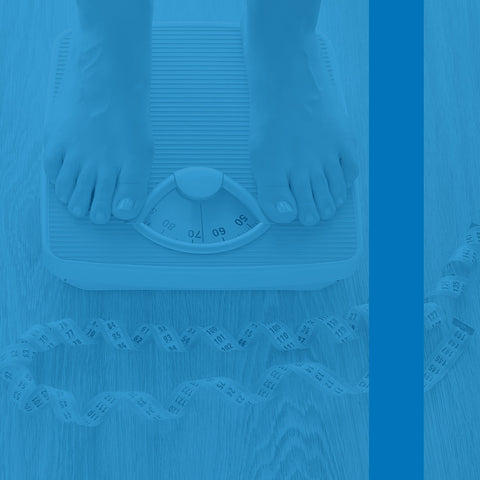
Gamma-aminobutyric acid (or GABA) is a widely distributed four-carbon free amino acid that is replete in vegetables, fruits, and fermented foods. GABA is produced from L-glutamic acid by glutamate decarboxylase and functions as a major inhibitory neurotransmitter in the central nervous system [1]. The role of GABA in the central nervous system is associated with the regulation of synaptic transmission, improving sleeplessness and depression, augmenting immunity, and regulating insulin secretion [2].
Recent studies have highlighted GABA to be beneficial in several ways, with multiple biological activities of GABA attributed to insulin metabolism [3,4]. Notably, signaling through GABA receptors has been associated with body weight as well as the growth and maintenance of skeletal muscle [4].
GABA could therefore be a potential therapeutic for the prevention and treatment of obesity, and this article will provide an overview of the evidence in this regard. For a deeper dive into GABA itself, you can read our in-depth guide here.
GABA controls feeding and metabolism
GABA has been proposed to play a key role in the cognitive choice of the type, quantity, and quality of food by regulating the transmission of signals between neurons in the brain circuitry [5]. As the major inhibitory neurotransmitter in the mammalian brain, GABA has been implicated in controlling excitability, the processing of information, plasticity, and the synchronization of neuronal activity [6]. Additionally, the involvement of GABA in eating behavior has been supported in experiments using rodent models and GABA receptor agonists and antagonists. Changes in brain glucose concentration can modify the release of neurotransmitters. For instance, hypoglycemic periods inhibit GABA release in the substantia nigra and ventral tegmental area, which are areas that project to the frontal cortex (FC) and increase dopamine concentration and disinhibit the FC.
Rodent studies have shown that the consumption of a high-fat diet reduces GABA levels in the FC and hippocampus, which could likely hamper the inhibitory processes that underpin feeding behavior. These findings support the view that GABA is implicated in the brain mechanisms underlying obesity and overfeeding [6].
Again in rodents, cutting-edge genetic methods have shown that inactivation of GABA signaling in the areas of the brain responsible for appetite brings about severe weight loss and glucose intolerance in young animals, but only transient appetite suppression in older animals [7].
GABA's role in reducing insulin resistance
The islet cells of the pancreas possess GABA-A receptors in humans, and research has suggested that GABA has the potential to improve beta cell mass and function [4,8,9]. In addition, GABA can help mitigate insulin resistance, likely through increasing the gene expression of glucose transporter 4 [10]. GABA also prevents beta cells (that secrete insulin) from apoptosis and its deficiency impacts insulin signaling in the skeletal muscle and liver [4,11].
Oral treatment with GABA in rodents has shown beneficial effects on fasting blood glucose, improved glucose tolerance, and insulin sensitivity following feeding with a high-fat diet [12]. The mechanisms for this are likely due to the inhibition of obesity-related inflammation and upregulating regulatory T-cell responses. It also significantly reduced the gain of body weight in mice fed a high-fat diet [12].
GABA's anti-obesity effects
In rodents, GABA substantially inhibits body mass gain by suppressing adipogenesis and lipogenesis [13]. Histological analysis (staining using a microscope) of white adipose tissue also demonstrated that GABA decreased adipocyte (fat cell) size. At the same time, GABA administration decreased fasting blood glucose and improved serum lipid profiles and hepatic lipogenesis in obese mice fed a high-fat diet. Overall, these results suggest that GABA exerts an anti-obesity effect mainly via the regulation of lipid metabolism.
Summary
This article has explored some of the mechanistic underpinnings of GABA in eating behavior and its relationship with several organ systems and tissues implicated in weight control. Although much of the existing evidence exists in cell and rodent models, it nevertheless indicates that GABA could have potential applications as a therapeutic strategy for weight control and, as a consequence, help to address the challenging metabolic diseases associated with obesity.
Here at Troscriptions, we have two products that modulate the GABA system. Tro Calm and Tro Zzz were engineered with your health in mind, offering stress relief and sleep solutions, respectively. So don't wait any longer — tap into the magic of GABA today with Tro Calm and Tro Zzz. Your brain will thank you for it!
References
[1] L. Sivilotti, A. Nistri, GABA receptor mechanisms in the central nervous system, Prog Neurobiol 36 (1991) 35–92. https://doi.org/10.1016/0301-0082(91)90036-z.
[2] D.-H. Ngo, T.S. Vo, An Updated Review on Pharmaceutical Properties of Gamma-Aminobutyric Acid, Molecules 24 (2019) 2678. https://doi.org/10.3390/molecules24152678.
[3] H. Jin, H.-J. Oh, B.-Y. Lee, GABA Prevents Age-Related Sarcopenic Obesity in Mice with High-Fat-Diet-Induced Obesity, Cells 12 (2023) 2146. https://doi.org/10.3390/cells12172146.
[4] H. Rezazadeh, M.R. Sharifi, N. Soltani, Insulin resistance and the role of gamma-aminobutyric acid, J Res Med Sci 26 (2021) 39. https://doi.org/10.4103/jrms.JRMS_374_20.
[5] A.M. Farrar, L. Font, M. Pereira, S. Mingote, J.G. Bunce, J.J. Chrobak, J.D. Salamone, Forebrain circuitry involved in effort-related choice: Injections of the GABAA agonist muscimol into ventral pallidum alter response allocation in food-seeking behavior, Neuroscience 152 (2008) 321–330. https://doi.org/10.1016/j.neuroscience.2007.12.034.
[6] C. Sandoval-Salazar, J. Ramírez-Emiliano, A. Trejo-Bahena, C.I. Oviedo-Solís, M.S. Solís-Ortiz, A high-fat diet decreases GABA concentration in the frontal cortex and hippocampus of rats, Biol Res 49 (2016) 15. https://doi.org/10.1186/s40659-016-0075-6.
[7] F. Meng, Y. Han, D. Srisai, V. Belakhov, M. Farias, Y. Xu, R.D. Palmiter, T. Baasov, Q. Wu, New inducible genetic method reveals critical roles of GABA in the control of feeding and metabolism, Proc. Natl. Acad. Sci. U.S.A. 113 (2016) 3645–3650. https://doi.org/10.1073/pnas.1602049113.
[8] N. Soltani, H. Qiu, M. Aleksic, Y. Glinka, F. Zhao, R. Liu, Y. Li, N. Zhang, R. Chakrabarti, T. Ng, T. Jin, H. Zhang, W.-Y. Lu, Z.-P. Feng, G.J. Prud’homme, Q. Wang, GABA exerts protective and regenerative effects on islet beta cells and reverses diabetes, Proc Natl Acad Sci U S A 108 (2011) 11692–11697. https://doi.org/10.1073/pnas.1102715108.
[9] I. Purwana, J. Zheng, X. Li, M. Deurloo, D.O. Son, Z. Zhang, C. Liang, E. Shen, A. Tadkase, Z.-P. Feng, Y. Li, C. Hasilo, S. Paraskevas, R. Bortell, D.L. Greiner, M. Atkinson, G.J. Prud’homme, Q. Wang, GABA promotes human β-cell proliferation and modulates glucose homeostasis, Diabetes 63 (2014) 4197–4205. https://doi.org/10.2337/db14-0153.
[10] H. Rezazadeh, M.R. Sharifi, M. Sharifi, N. Soltani, Gamma-aminobutyric acid attenuates insulin resistance in type 2 diabetic patients and reduces the risk of insulin resistance in their offspring, Biomedicine & Pharmacotherapy 138 (2021) 111440. https://doi.org/10.1016/j.biopha.2021.111440.
[11] A. Hosseini Dastgerdi, M. Sharifi, N. Soltani, GABA administration improves liver function and insulin resistance in offspring of type 2 diabetic rats, Sci Rep 11 (2021) 23155. https://doi.org/10.1038/s41598-021-02324-w.
[12] J. Tian, H.N. Dang, J. Yong, W.-S. Chui, M.P.G. Dizon, C.K.Y. Yaw, D.L. Kaufman, Oral Treatment with γ-Aminobutyric Acid Improves Glucose Tolerance and Insulin Sensitivity by Inhibiting Inflammation in High Fat Diet-Fed Mice, PLoS ONE 6 (2011) e25338. https://doi.org/10.1371/journal.pone.0025338.
[13] H. Jin, H. Han, G. Song, H.-J. Oh, B.-Y. Lee, Anti-Obesity Effects of GABA in C57BL/6J Mice with High-Fat Diet-Induced Obesity and 3T3-L1 Adipocytes, IJMS 25 (2024) 995. https://doi.org/10.3390/ijms25020995.





Comments (0)
There are no comments for this article. Be the first one to leave a message!